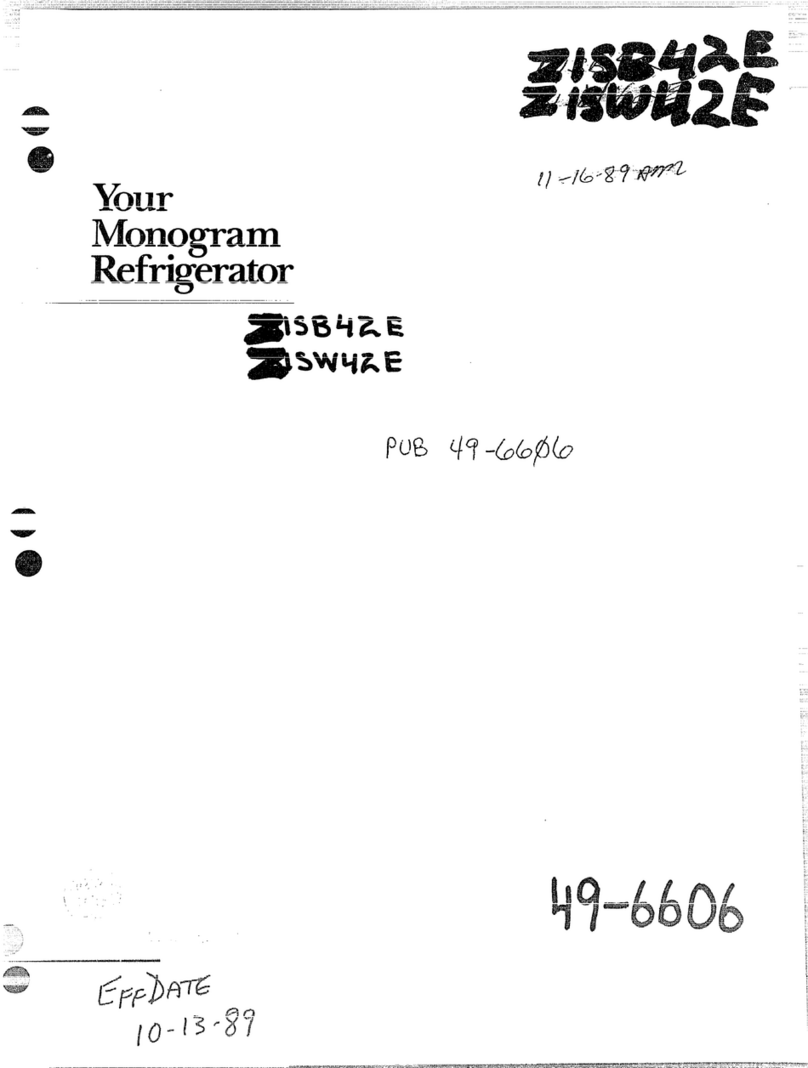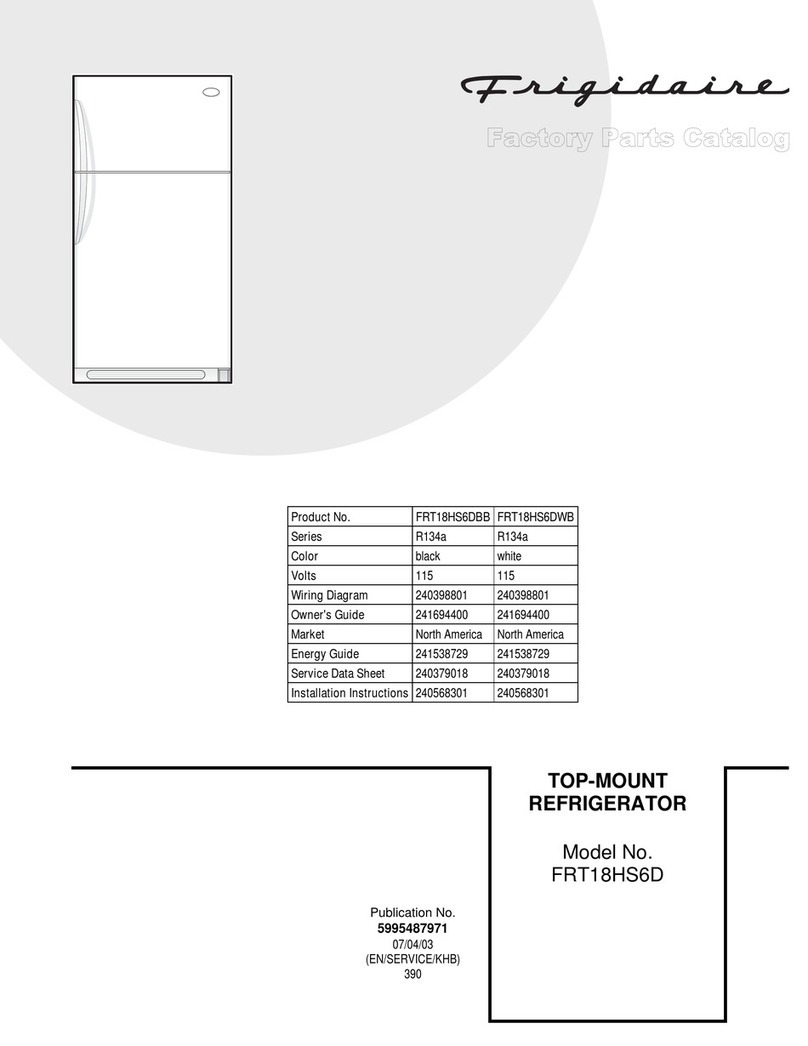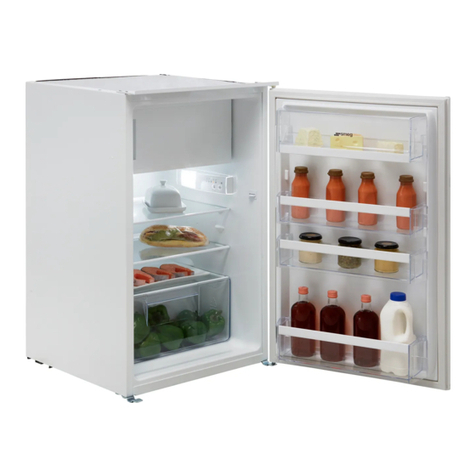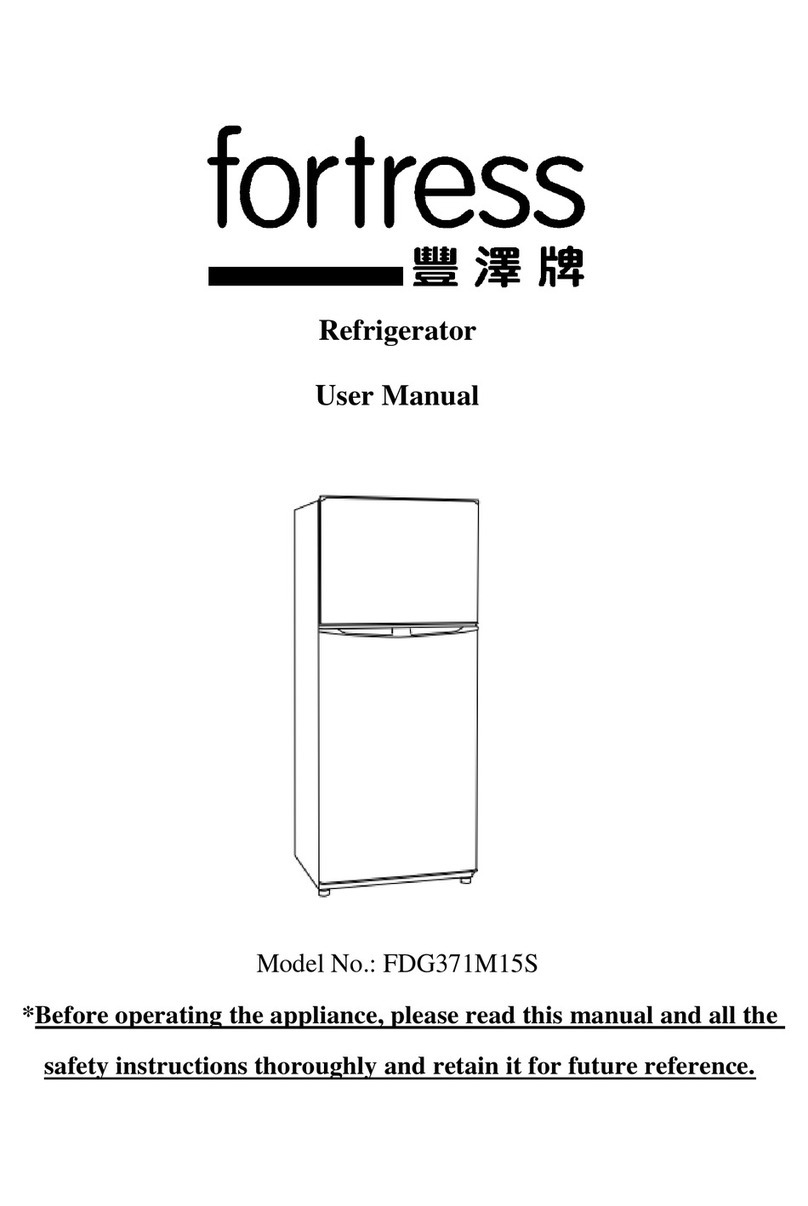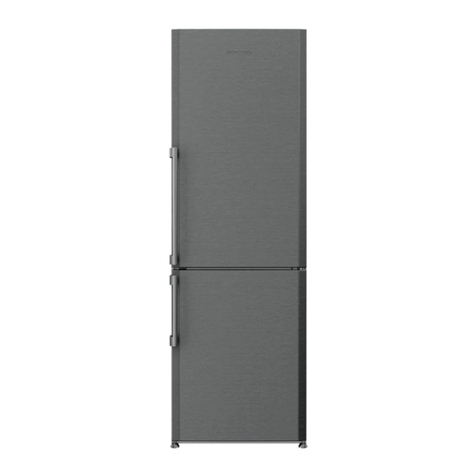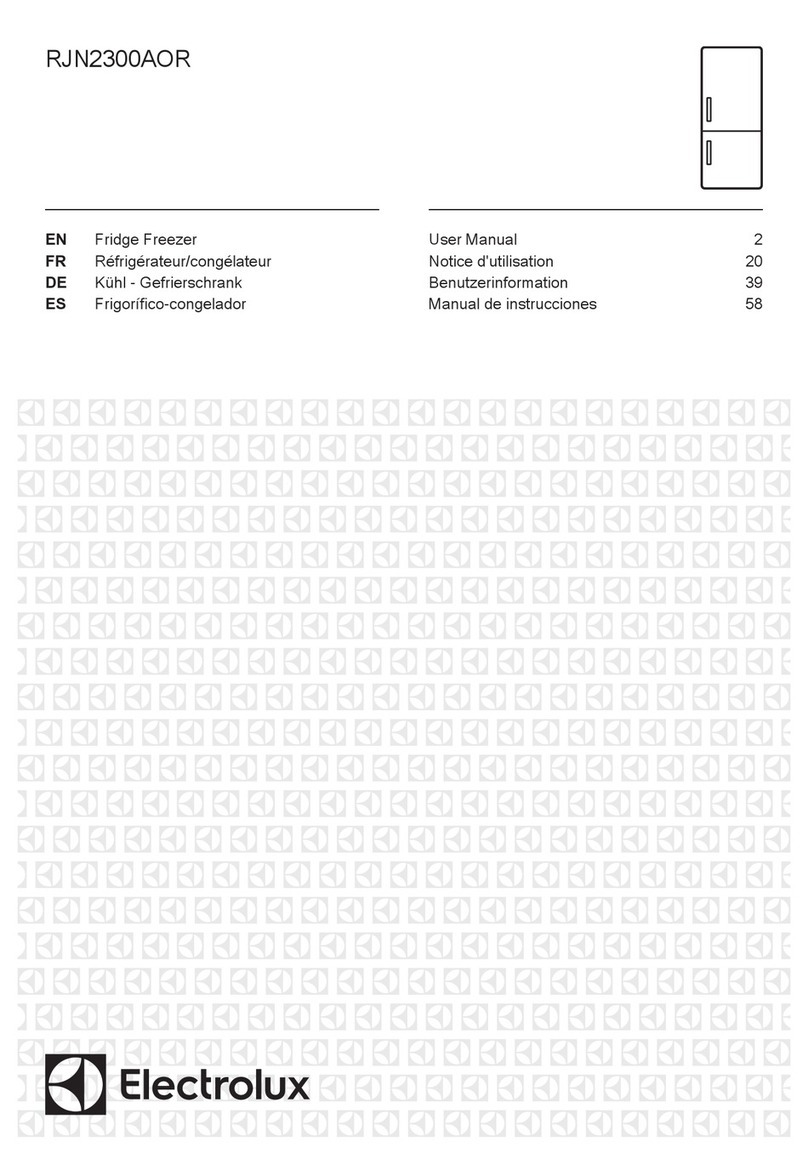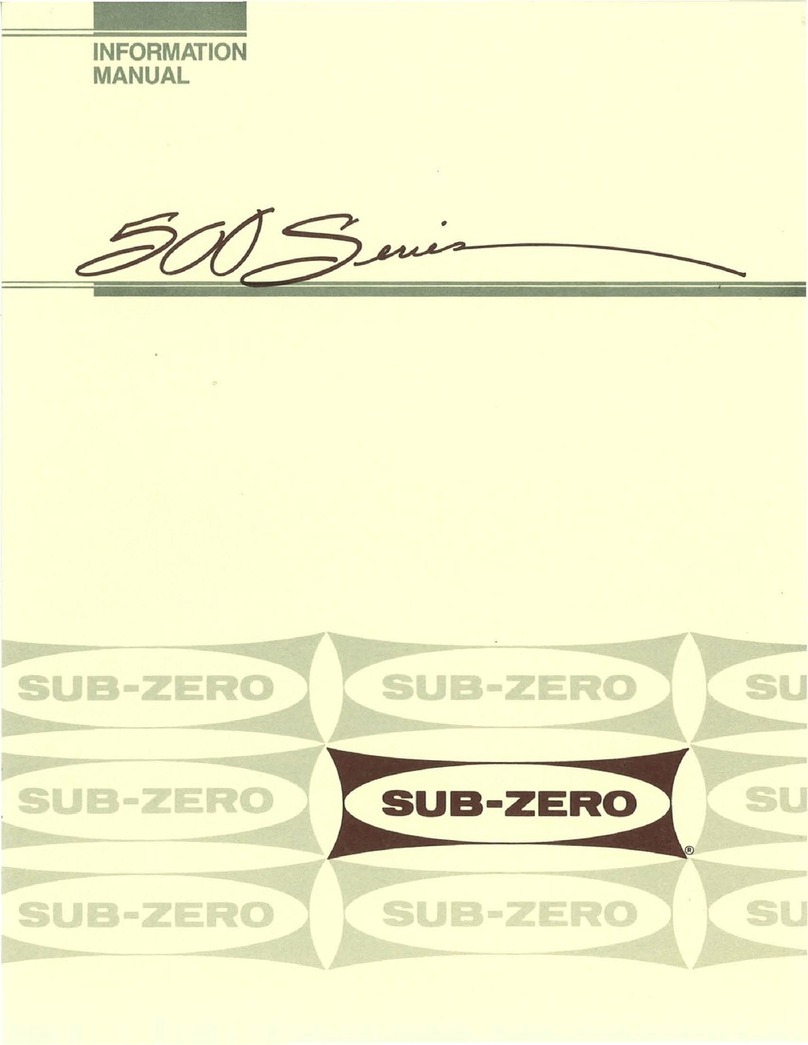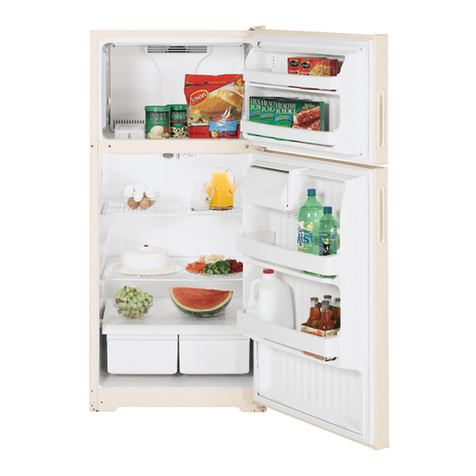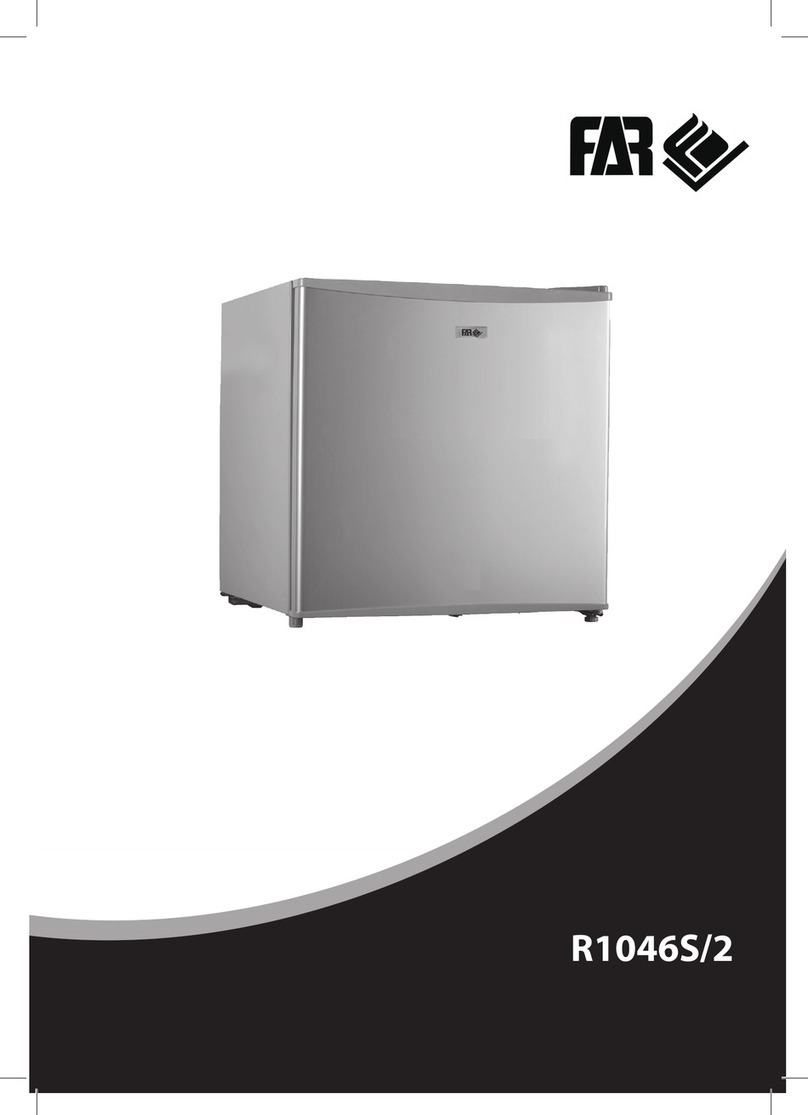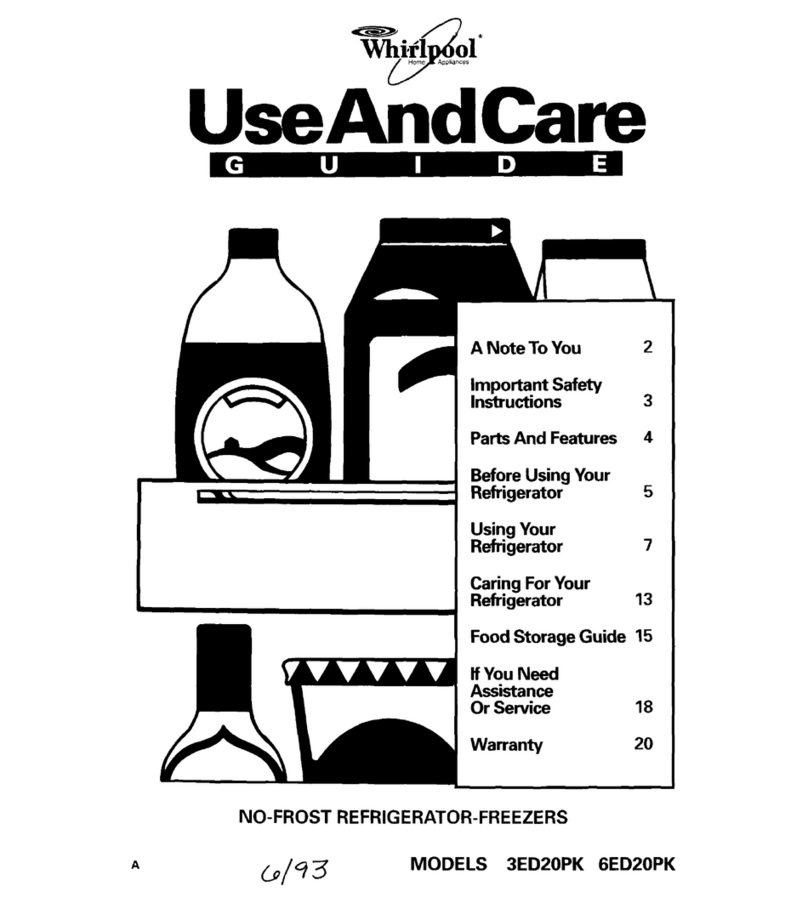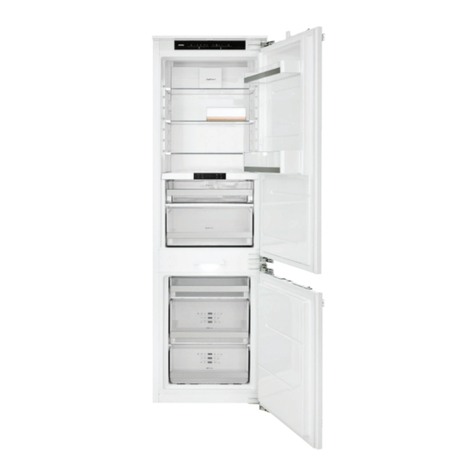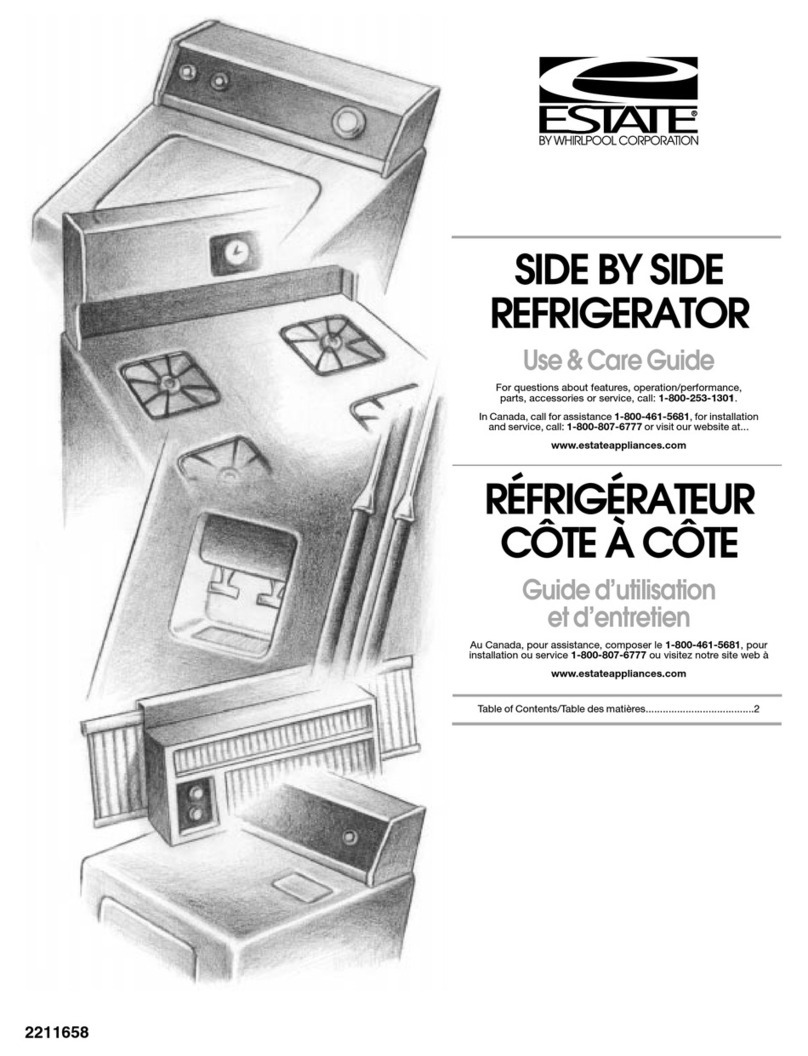Dellcool XCD-90B Operating manual

User and Installation Manual
Absorption refrigerator for recreational vehicles
Models: XCD-90B
Read manufacturer’s instructions before use
1

2
Warning:
FOR YOUR SAFETY
Please read this instruction manual carefully before operating the unit.
Do not store or use gasoline or other flammable vapors and liquids in the vicinity
of this or any other appliance.
If you smell gas:
1. Open windows.
2. Do not attempt to light appliance.
3. Do not touch electrical switches.
4. Extinguish any open flame.
5. Shut off fuel supply.
6. Evacuate immediately and call emergency services.

Table of Contents Page
Safety Introduction………………………………………………………………………….4
Instructions…………………………………………………………………………………..5
Installation instructions……………………………………………………………………..7
Operation Instructions………………………………………………………………………9
Trouble Shooting and Maintenance………………………………………………………12
Maintenance………………………………………………………………………………...13
Wiring Diagram……………………………………………………………………………..15
Limited Warranty……………………………………………………………………………15
Schedule 1…………………………………………………………………………………..16
Schedule 2…………………………………………………………………………………..17
REFERENCE INFORMATION:
Please complete the following information for future reference. You will
need it to obtain warranty service.
Model Name*: __________________________________
Serial Number *: __________________________________
Date and place of Purchase: __________________________________
*The above information is written on the nameplate inside the cabinet. Retain
this user manual with your sales receipt as a permanent record of your
purchase.
3

1. Safety Instructions
Before you use your absorption refrigerator, please read this instruction manual carefully
1.The appliances are suitable for installation in recreation vehicles such as caravans and motor homes.
2.The appliance may be connected to more than one source of energy.
3.The appliance shall not be exposed to rain.
4.This appliance can be used by children aged from 8 years and above and persons with reduced physical, sensory or mental
capabilities or lack of experience and knowledge if they have been given supervision or instruction concerning use of the
appliance in a safe way and understand the hazards involved.
- Children shall not play with the appliance.
- Cleaning and user maintenance shall not be made by children without supervision.
5.This appliance is not intended for use by persons (including children) with reduced physical, sensory or mental capabilities, or
lack of experience and knowledge, unless they have been given supervision or instruction concerning use of the appliance by a
person responsible for their safety.
6.Your refrigerator should be used only by those who have read this manual or those that have been adequately instructed by
someone who has read it.
7.Children should be supervised to ensure that they do not play with the appliance, even when it is turned off.
8.This absorption refrigerator must be properly installed in accordance with the installation instructions before it is used.
9.WARNING: To avoid a hazard due to instability of the appliance, it must be fixed in accordance with the instructions.
10.The appliances must be installed by after-sale service technician from our company or our dealers.
11.Do not use to store liquids such as gasoline, kerosene, etc., inside your refrigerator, thus avoiding the risks of
explosions and fire.
12.Do not store toxic materials inside your refrigerator, as they could contaminate food items.
13.Do not store explosive substances such as aerosol cans with a flammable propellant in this appliance.
14.–WARNING: Keep ventilation openings, in the appliance enclosure or in the built-in structure, clear of obstruction.
15.–WARNING: Do not use mechanical devices or other means to accelerate the defrosting process, other than those
recommended by the manufacturer.
16.–WARNING: Do not damage the refrigerant circuit.
17.–WARNING: Do not use electrical appliances inside the food storage compartments of the appliance, unless they are of the
type recommended by the manufacturer.
18.If the supply cord is damaged, it must be replaced by the manufacturer or its service agent or a similarly qualified person in
order to avoid a hazard.
19.These appliances use flammable insulation blowing gas and refrigerant. Please dispose the appliance according to the local
regulation.
20.For the battery supply connection, an all-pole disconnection device rated more than 20A at least must be equipped that
provides full disconnection under overvoltage category III conditions according to wiring rules such as a circuit breaker.
21.After installation, the connection of main supply shall be accessible and the plug can be easily unplugged.
22.When installed in the RV, the burner/flue system and gas line must be completely sealed from the living area.
23.It is strongly recommended that a carbon monoxide detector is installed in the vehicle.
24.The furniture, both the sides and back wall, bottom floor, in which the refrigerator is installed, must not be flammable.
25.Cut off the gas/electricity supply before cleaning or before making any repairs.
26.If for any reason this product requires service, only a certified technician is allowed to perform the service.
27.Do not operate your absorption refrigerator in the presence of explosive fumes.
28.Before discarding or storing, we recommend that you remove the door and leave the shelves in place. This will reduce the
possibility of danger to children.
29.The sealed cooling system must not be opened, since it contains corroding chemicals under high pressure.
30.Check that the gas supplied to the refrigerator is set at the correct pressure. See the pressure regulator on the LP gas tank.
4

2. Introduction
Thank you for choosing our gas refrigerator.
Please read through these instructions carefully before operating this refrigerator. When using it, always
exercise safety instructions.
This refrigerator is designed for installation in recreation vehicles such as caravans and motor homes. It is
intended to be built inside a cupboard enclosure.
This manual will guide you to getting the best use of this refrigerator.
Transit damage
Inspect the refrigerator for damage. Transit damage must be reported to whoever is responsible for delivery
not later than seven days after the refrigerator was delivered.
Power source requirements
This refrigerator is designed to operate with these energy sources:
Type of GAS: PROPANE pressure 11"w.c.
AC operation: 110-120V 60Hz
DC operation: DC 12V
Operating in excess of these specifications can damage the refrigerator’s electrical circuit, related
components and voids the refrigerator’s warranty.
The manufacturer reserves the right to make changes to its products when considered necessary
and useful, without affecting the essential safety and operating characteristics. We are therefore not
responsible for any inaccuracies due to printing, transcription, or conversational errors, whether
contained in any printed source, or relayed in person.
From the cooling unit pressure test report, no leakage and deformation was observed for
the cooling unit at pressure 15 Mpa.
We can get the conclusion that this cooling unit complies with ANSI Z21.74, 1.10.
Energy-saving tips
At an average ambient temperature of 77°F (25°C), it is sufficient to operate the refrigerator at middle thermostat
setting. Where possible, always store precooled products.
Do not expose the refrigerator to direct sunlight.
Ensure that air circulation of the cooling unit is not obstructed.
Defrosting at regular intervals saves energy (see section Operation instructions “Defrosting”).
Open the refrigerator door only for a short period of time when removing products.
Run the refrigerator under 110-120V or gas for about 12 hours before filling it.
5

Parts and Features
1 Control panel
2 Lock and handle
3 Freezer Door
4 Fin
5 Drip tray
6 Crisper
7 Balcony
6

3. Installation Instructions(See the schedule 1. 2)
1. The refrigerator is designed to install into enclosure in the vehicle. No clearance is required on both sides. Bottom must be
leveled very well. Particularly a cut-out should be left for hinge to access.
2. The floor must be solid and level and must be able to support the weight of the refrigerator and contents. Never install the
refrigerator directly on carpeting.
3. When installing the refrigerator into the enclosure recess, all areas within the recess must be sealed to prevent exhaust fumes
from entering the living space. It is recommended to use sponge strip to seal the rear part, including the combustion system, from
the living space. Make sure the sponge is compressed well for good seal.
4. A T shape exhaust pipe extension is provided and should be fitted.
5. The refrigerator must be secured in place with four screws, two on each side.
6. The opening of the enclosure for installation should be at least 20.7"(526 mm)wide, 22.8"(580mm) deep and 29.8"(758mm)
high.
7. A lower vent and an upper vent are required for ventilation. Opening of the both vents should be 250cm2minimum.
8. After installation, the connection of main supply shall be accessible and the plug can be easily unplugged.
9. Three typical installations are illustrated as below.
10. Install the seven screws in the following order (Use the screws in the parts bag):
10.1 Six screws installed through the front frame;
10.2 One screw installed in the rear base.
7

Gas connection
The refrigerator is designed to work on LPG gas, not natural gas or town gas.
Check that the pressure of supplied gas is 11 inches water column.
A suitable threaded coupling must be used to connect the gas pipe to the inlet.
Leakage test must be carried out after the connection is done.
Never use open flame to do leakage check.
AC 110-120V connection
The main AC terminal is inside the junction box. The cable must be secured
with clip tightly. Junction box cover is supplied separately.
After the main AC cable is connected, remember to secure the box cover on.
Note: The supply cord shall be H05VV-F and the minimum cross-sectional
area of conductors is 18AWG
DC12V connection
Follow the terminal indication to connect the DC power.
Do not reverse the positive and negative.
Please note that there two connectors for LED lamp
and DC heater separately.
Note: The minimum cross-sectional area of conductors for heater is 14AWG
The minimum cross-sectional area of conductors for lamp is 18AWG
8

3. Operation Instructions
The power selector has five positions:
- Main supply AC (110V-120V) - DC 12V - Gas - Switch off (2 positions)
Gas Operation
Prior to starting gas operation, open the gas cylinder valve and the shut-off valve for
gas supply to the refrigerator.
After initial operation, servicing or changing gas cylinders etc., the gas pipes may
contain some air which should be allowed to escape by depressing the button (D).
This will ensure that the flame lights right away.
1. Set the power selector knob (A) to gas mode. See right fig.
2. Depress the safety valve button (D) and hold it down while depressing the
igniter button (B).
3. Check the flame indicator (C) to see whether the flame is alight. The pointer
should move from red to green section after the flame is lighted.
4. Keep the safety valve button (D) depressed for a further 10-15 seconds.
5. Release the safety valve button (B) and again check that the flame is alight.
Note: If the battery ignition fails to spark, you might need to replace the battery.
AC Operation
1. Set the power selector knob (A) to AC mode. See right Fig.
2. Have the AC power connected to the refrigerator.
The AC power should comply with what is specified in the data
plate. Any difference in values may result in damages to the
refrigerator!
DC Operation
Set the power selector knob (A) to DC mode. See right fig.
The DC mode is only designed to be used when driving. Otherwise
your battery will be discharged within a few hours!
To terminate any power mode, gas, AC or DC, turn the knob A to either of two OFF positions.
9
A: Power selector B: Battery igniter C: Flame indicator D: Safety valve E: Thermostat

Regulating the temperature
The right fig shows the thermostat. Turn the knob clockwise to get lower temperature inside.
It will take several hours for the refrigerator to reach normal operating temperature.
Please note that too much lower temperature might make vegetables or eggs frozen.
DC power is not regulated by this thermostat.
Turning off the refrigerator
If the refrigerator is not to be used for a period:
1. Shut off any valve in the gas line to the refrigerator.
2. Empty the refrigerator. Defrost and clean it. It must be completely dry inside to avoid mold growth.
3. Pull out the hook as figs below and secure it to the hole underneath the front cover. This will allow the door to be
open slightly always and get air circulated.
Winter Operation
If the ambient temperature is lower than 10 degrees, the winter cover should be fitted. This will protect the cooling unit
from excessively cold air which might result in too much strong or even poor performance of the unit.
Insert Decor Panel
The doors are designed to accept decorative door panels to match the kitchen décor. The decorative panels must be
4 mm or less in thickness. Door panels should be installed in the refrigerator doors before installing the refrigerator in
the vehicle. The door panel dimensions for XCD-90B are 19.1"(485±0.5mm) wide by 26.3"(670±0.5mm) high.
To install the door panels, first pull the panel retainer off the bottom of the door by removing two screws. Push the
door panel into the slots of the door and put the panel retainer back into place to hold the panel inside the door. See
Fig below.
10

Replace the battery for electronic spark ignition (Fig 1, Fig 2)
The battery for ignition is mounted inside the right lamp box. Remove the light cover with a knife. You can get access
to the battery. Simply replace the battery with a new one and put the cover back.
Fig 1 Fig 2 Fig3
The lighting in the cabinet (Fig 3)
The lighting of this refrigerator uses LED, which is with high brightness, no heat emission and long service life, and
the light switch is controlled by the door, which means the inside light will start illuminating automatically when the
door is opened. Please pay attention that if there is malfunction with the light, please contact the after-sales service
department of this product or professionals for examination.
Food Storage
The freezer compartment is not intended for quick freezing of foods. It keeps food frozen.
The fresh food compartment stores and cools food. For best cooling performance, air must circulate within the fresh
food compartment. Do not cover the shelves with paper, plastic, etc.
To reduce frost on the cooling fins, cover liquids and moist foods. Do not place hot foods in the compartment, and do
not leave the door open longer than needed.
The door storage areas hold items such as 1.5-liter bottles, pop cans, and other commonly used items.
Allow the refrigerator to cool for 8 hours before loading foods. Loading a warm refrigerator with warm food increases
the cool down period.
Never keep items in the refrigerator which might give off flammable gases.
Never put bottles or cans of fizzy drinks in the frozen food storage compartment as they may burst when freezing.
Also don’t give children ice stuff straight from the frozen food as they could cause frostbite. Most kinds of frozen food
can be stored in the frozen food compartment for about a month. This period of time may vary, however, and it is
important to follow the instructions on the individual packets.
Warning about the use of your refrigerator:
When storing your food, be particularly careful about the special conditions of use of a refrigerator located in a vehicle.
The conditions inside the vehicle change a lot depending on:
- The weather conditions
- The high temperature inside the vehicle especially if the vehicle is parked in the sun. The temperature may then
reach 122°F (50°C).
- The use of the 12 V source during a long trip.
- The refrigerator being located behind a window facing the sun.
- In using the refrigerator too quickly after power-optimal temperature.
Under those circumstances, the refrigerator may not keep the temperature low enough for the food preservation
(especially highly perishable food).
List of highly perishable food: meat, fish, poultry, pork butchery precooked dish and all the products which need to be
stored at 4-6°C max.
11

Always remember:
- Wrap up separately raw food and cooked food in aluminum or plastic wrap.
- Don’t remove the packing if useful information about the product are written on it.
- Don’t leave refrigerated products outside the refrigerator too long.
- Put the products that have to be eaten first in the front of the refrigerator.
- Put left-overs in sealed boxes and eat them rapidly.
- Wash your hands carefully before touching any food and before eating.
- Wash your refrigerator regularly. Use soap and water to wash it.
The use by date appears as follow: “Best before…” followed by the date or the information to know where the date
appears on the labelling.
Ice-Making
Fill the ice tray just below the brim with drinking water and place it on the freezer compartment.
It is possible to make ice faster by turning the control knob temporarily to its highest value but do not forget to turn it
back to its regular setting afterwards as the refrigerator might otherwise become too much cold.
Defrosting
Frost will gradually accumulate on the refrigerating surfaces. It must not be allowed to grow too thick as it acts as
insulation and adversely affects refrigerator performance.
Check the formation of frost regularly every week and when it gets about 3 mm thick, defrost the refrigerator. To
defrost the refrigerator, turn it off and remove the ice tray and all food items.
Warning: normally the temperature of items of frozen foods would rise unduly during defrosting and so they should
be consumed within 24 h or discarded.
Do not try to accelerate defrosting by using any kind of heating appliance, as this might damage the plastic surfaces
of the refrigerator. Neither should any sharp objects be used to scrape off the ice.
The defrost water runs through the drainage pipe to a receptacle at the rear of the refrigerator where it evaporates.
Defrost water in the freezer compartment should be mopped up with a cloth.
When all ice has melted, wipe the refrigerator dry and restart it.
Place the food items back inside but wait until the refrigerator is cold before making ice cubes
Trouble Shooting and Maintenance
If the refrigerator fails to work, check the following points before calling a service technician:
1. That the above installation and operating instructions have been followed.
2. The refrigerator is level.
3. If it is possible to start the refrigerator on any of the connected sources of energy.
4. If the refrigerator fails to work on gas, check:
-That the gas bottle is not empty.
-That all LP-gas valves are open.
5. If the battery ignition fails to spark, replace the battery if necessary.
If the refrigerator is not cold enough it may be because:
1. The ventilation of the cooling unit is inadequate.
2. The thermostat is set on the high temperature position.
3. The doors are opened frequently, or the gasket is not sealed properly.
4. Too much food is put at one time.
5. The gas pressure is incorrect - check the pressure regulator at the gas container.
If the refrigerator still does not work properly, call a service technician.
The sealed cooling system must not be opened, since it contains corroding chemicals under high pressure.
Do not use open flame to check for leakage in the gas tubes!
12

6. Maintenance
Inspect the gas hose periodically for cracks or deep chafing marks. Connections can be tested for leaks using a soap
solution.
Cleaning the refrigerator
General: Do not use harsh chemicals, abrasives, ammonia, chlorine bleach, concentrated detergents, solvents or
metal scouring pads. SOME of these chemicals may dissolve, damage and/or discolor your absorption refrigerator.
1. Remove the contents of the appliance
2. Wipe the inside and outside surfaces with a damp cloth. The addition of vinegar to the water is good for the
prevention of mold and fungus.
3. Wipe all parts thoroughly after the cleaning.
The cooling unit behind the refrigerator should be cleaned with a brush from time to time, but make sure that the
refrigerator is switched off when doing this.
The entire unit must be left for drying completely after cleaning with damp cloth
Cleaning the burner
Changing the heating element
The heater which is fitted inside the boiler casing (B), of the refrigerator unit, can be changed as follows:
1. Pull the power cord out of the wall socket.
2. Remove the cover C.
3. Remove some insulation wool so that the
heater Ais accessible.
4. Open the terminal block cover and
disconnect the heater leads.
5. Turn and lift the heater out of its pocket.
6. Fit the new heater into the pocket.
7. Connect the leads and close the terminal
Block cover.
8. Carefully put the insulation wool back.
13
Take off the protection hood and do the following:
1. Clean the openings and the burner screen with a toothbrush;
2. Clean and inspect the electrode and thermocouple. If it is
corroded, have it changed. Check that they are well attached and
if necessary tighten the screws.
3. Check that the spark is created by pressing the electric ignition
button on the control panel.
4. Do not use thin objects to either clean or unblock the injector

Cleaning the Cooling System and Flue tube
WARNING Carbon Monoxide can be hazardous to your health. Gas appliances may emit excessive Carbon
Monoxide if the refrigerator’s burner, burner orifice, and the flue tube are not regularly cleaned. To prevent Carbon
Monoxide, the burner, burner orifice, and the cooling system’s flue tube must be cleaned at least once a year and
after all prolonged (seasonal) shut-down periods. Refer to the following cleaning procedures and contact a qualified
installer from your dealer.
Before cleaning, put a cloth on the burner to protect it from dirt;
1. Remove the refrigerator from its enclosure.
2. Remove the exhaust pipe extension from the flue.
3. Remove the spiral flue baffle from the flue tube.
4. Using a stiff brush or fine emery cloth, clean the spiral flue baffle of debris.
5. Clean the inside of the flue tube with a flue brush. Inspect burner after cleaning.
6. Re-install the spiral flue baffle. Insure the spiral flue baffle is securely in place. The spiral flue baffle is required for
efficient cooling while operating in the gas mode.
14

7. Circuit Diagram
Limited Warranty
As a condition to any warranty service obligation, the consumer must present the Warranty Certificate along with a
copy of the original purchase invoice.
THIS WARRANTY DOES NOT COVER:
1) Damage, accidental or otherwise, to the absorption refrigerator while in the possession of a consumer not caused
by a defect in material or workmanship.
2) Damage caused by consumer misuse, tampering, or failure to follow the care and special handling provisions in
the instructions.
3) Damage to the finish of the case, or other appearance parts caused by wear
4) Damage caused by repairs or alterations of the absorption refrigerator by anyone other than those authorized by
the manufacturer.
5) Freight and Insurance cost for the warranty service
ALL WARRANTIES, INCLUDING ANY IMPLIED WARRANTY OF MERCHANT ABILITY ARE LIMITED TO
CLAIMED DURATION. THE MANUFACTURER DISCLAIMS ANY LIABILITY FOR CONSEQUENTIAL OR
INCIDENTAL DAMAGES
15

Schedule 1
The Frist Installation
1. Install the seven screws in the following order (Use the screws in the parts bag.):
1.1 Six screws installed through the front frame;
1.2 One screw installed in the rear base.
2. To install the ventilation grills, cut two rectangles17.8" x 6.2” (452 mm x 158 mm) in the outer wall of the vehicle. The
distance between the two holes is defined as: take the bottom of the refrigerator cabinet as the reference for opening,
size A is 3.1"(79mm), and size B is 24.1"(612mm); The ventilation grilles must have an open cross section of at least
400 cm².
3. The refrigerator is certified to operate in an enclosure with zero clearance to combustible materials refrigerator as
illustrated in for the top (G), sides (K), bottom (L) of the refrigerator; Allow a gap of 0.6- 0.8"(15-20 mm) between the
back wall (M) of the recess and the refrigeration unit.
4. The exhaust gas duct system must be made in such a manner as to achieve a complete extraction of combustion
products to the outside of living space. The flue gas is vented directly through the upper grille. Do not use any kind of
aluminium flue pipe to lead the flue gas out. The T-piece must be turned towards the outer wall.
5. The opening of the enclosure for installation should be at least 20.7" (526 mm) wide, 22.8" (580mm) deep and 29.8"
(758mm) high.
16

Schedule 2
The Second Installation
1. Install the seven screws in the following order(Use the screws in the parts bag.):
1.1 Six screws installed through the front frame;
1.2 One screw installed in the rear base.
2. To install the ventilation grills, cut one rectangle 17.8" x 6.2" (452 mm x 158 mm) in the outer wall of the vehicle,the
distance is defined as: take the bottom of the refrigerator cabinet as the reference for opening, size (A) is 3.1" (79mm), cut
one rectangles 20.53.1" *3.93.1" (520mm x 100 mm) in the roof of the vehicle; The ventilation grilles must have an open
cross section of at least 400 cm².
3. The refrigerator is certified to operate in an enclosure with zero clearance to combustible materials refrigerator as
illustrated in for the top (G), sides (K), bottom (L) of the refrigerator; Allow a gap of 0.6- 0.8"(15-20 mm) between the back
wall (M) of the recess and the refrigeration unit.
4. The exhaust gas duct system must be made in such a manner as to achieve a complete extraction of combustion
products to the outside of living space. The flue gas is vented directly through the upper grille. Do not use any kind of
aluminium flue pipe to lead the flue gas out. The T-piece must be turned towards the outer wall.
5. The opening of the enclosure for installation should be at least 20.7" (526 mm) wide, 22.8" (580mm) deep and 29.8"
(758mm) high.
17
Table of contents

